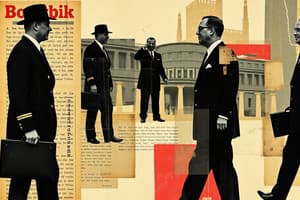Podcast
Questions and Answers
What is the primary transformation in the nature of the employment relationship due to collective agreements?
What is the primary transformation in the nature of the employment relationship due to collective agreements?
- From individual contract to group contract
- From a temporary to a permanent relationship
- From an individual employee-to-employer contract to a union-to-employer legal relationship (correct)
- From a verbal agreement to a written contract
Which of the following is a mandatory term that must be included in a collective agreement?
Which of the following is a mandatory term that must be included in a collective agreement?
- An outline of employee benefits
- A clause for annual evaluations
- A prohibition against strikes and lockouts during the term of the agreement (correct)
- A bonus structure for overachieving employees
What does the scope clause in a collective agreement signify?
What does the scope clause in a collective agreement signify?
- The terms under which disputes can be settled
- The employer's recognition of the union as the sole bargaining agent for a specified employee group (correct)
- The duration for which the agreement is valid
- A statement regarding employee training programs
Which term describes a clause requiring employers to deduct union dues from employees’ pay?
Which term describes a clause requiring employers to deduct union dues from employees’ pay?
What is the minimum term required for a collective agreement as per labour relation legislation?
What is the minimum term required for a collective agreement as per labour relation legislation?
Which of the following articles is prohibited in collective agreements?
Which of the following articles is prohibited in collective agreements?
How do collective agreements affect human resources management?
How do collective agreements affect human resources management?
What is one common practice in traditional adversarial bargaining?
What is one common practice in traditional adversarial bargaining?
What is a mandatory term in a collective agreement regarding union dues?
What is a mandatory term in a collective agreement regarding union dues?
What does the term 'seniority' refer to in a collective agreement?
What does the term 'seniority' refer to in a collective agreement?
What is the role of management rights in collective agreements?
What is the role of management rights in collective agreements?
Which of the following is a prohibited term in a collective agreement?
Which of the following is a prohibited term in a collective agreement?
What conditions can lead to deemed termination of an employee?
What conditions can lead to deemed termination of an employee?
In a collective agreement, what is a common reason for an employer to impose discipline?
In a collective agreement, what is a common reason for an employer to impose discipline?
What is a policy grievance?
What is a policy grievance?
In terms of union dues, what is the service fee based on?
In terms of union dues, what is the service fee based on?
What must be negotiated between the employer and the union regarding leaves of absence?
What must be negotiated between the employer and the union regarding leaves of absence?
Which of the following correctly describes a strike?
Which of the following correctly describes a strike?
What happens to unresolved grievances?
What happens to unresolved grievances?
Which of the following is NOT a type of grievance?
Which of the following is NOT a type of grievance?
What is a lockout?
What is a lockout?
What is the minimum duration for a collective agreement in all jurisdictions?
What is the minimum duration for a collective agreement in all jurisdictions?
What is meant by rights arbitration?
What is meant by rights arbitration?
What percentage of collective agreement terms had a duration of more than three years in 2015?
What percentage of collective agreement terms had a duration of more than three years in 2015?
What is a characteristic of the 'Conflict' type of union-management relationship?
What is a characteristic of the 'Conflict' type of union-management relationship?
Which factor can increase union pressure during negotiations?
Which factor can increase union pressure during negotiations?
What is the primary purpose of the 'Notice to Bargain' in the negotiation process?
What is the primary purpose of the 'Notice to Bargain' in the negotiation process?
What does 'Duty to Bargain in Good Faith' entail?
What does 'Duty to Bargain in Good Faith' entail?
How do external economic factors primarily influence union pressure?
How do external economic factors primarily influence union pressure?
What role do bargaining teams play in the negotiation process?
What role do bargaining teams play in the negotiation process?
Which type of union-management relationship involves working together towards common goals?
Which type of union-management relationship involves working together towards common goals?
Which aspect is NOT typically involved in the bargaining structure of public service negotiations?
Which aspect is NOT typically involved in the bargaining structure of public service negotiations?
Flashcards
Collective Agreement
Collective Agreement
A legally binding contract between an employer and a union that establishes the terms and conditions of employment for unionized workers.
Collective Bargaining
Collective Bargaining
The process of negotiating terms and conditions of employment between union representatives and employer representatives.
Union Recognition Clause
Union Recognition Clause
A section in a collective agreement that establishes the group of employees represented by the union.
No Strike/Lockout Clause
No Strike/Lockout Clause
Signup and view all the flashcards
Arbitration
Arbitration
Signup and view all the flashcards
Check-Off Clause
Check-Off Clause
Signup and view all the flashcards
Mandatory Terms in a Collective Agreement
Mandatory Terms in a Collective Agreement
Signup and view all the flashcards
Voluntary Terms in a Collective Agreement
Voluntary Terms in a Collective Agreement
Signup and view all the flashcards
Grievance
Grievance
Signup and view all the flashcards
Grievance and Arbitration Process
Grievance and Arbitration Process
Signup and view all the flashcards
Individual Grievance
Individual Grievance
Signup and view all the flashcards
Group Grievance
Group Grievance
Signup and view all the flashcards
Policy Grievance
Policy Grievance
Signup and view all the flashcards
Rights Arbitration
Rights Arbitration
Signup and view all the flashcards
Strike
Strike
Signup and view all the flashcards
Lockout
Lockout
Signup and view all the flashcards
Union dues
Union dues
Signup and view all the flashcards
Service fee (for non-union members)
Service fee (for non-union members)
Signup and view all the flashcards
Management rights
Management rights
Signup and view all the flashcards
Bargaining unit work
Bargaining unit work
Signup and view all the flashcards
Seniority
Seniority
Signup and view all the flashcards
Discipline and discharge
Discipline and discharge
Signup and view all the flashcards
Deemed termination
Deemed termination
Signup and view all the flashcards
Leaves of absence
Leaves of absence
Signup and view all the flashcards
Notice to bargain
Notice to bargain
Signup and view all the flashcards
Bargaining teams
Bargaining teams
Signup and view all the flashcards
Duty to bargain in good faith
Duty to bargain in good faith
Signup and view all the flashcards
Bargaining structure
Bargaining structure
Signup and view all the flashcards
Union-Management Relationship
Union-Management Relationship
Signup and view all the flashcards
Influencing factors
Influencing factors
Signup and view all the flashcards
Negotiation process
Negotiation process
Signup and view all the flashcards
Study Notes
Industrial Relations - Week 8
- This week's topic is the Collective Agreement & Negotiation.
- The professor is Qian Zhang.
- The course code is ADM3334.
- Pedagogical values and goals include student success, knowledge of Industrial Relations, a safe and caring environment, and student well-being.
- The professor is dedicated to helping students.
Course Schedule
- Oct 21: Union Organizing Drive and Certification, Chapter 6, Group Assignment 1 due before class.
- Oct 28: The Collective Agreement, Chapter 7.
- Nov 4: Negotiation of the Collective Agreement, Chapter 8.
- Nov 11: Strikes, Lockouts, and Contract Dispute Resolution, Chapter 9, Group Assignment 2 due before class.
- Nov 18: Administration of the Collective Agreement, Chapter 10, In-class activity.
- Nov 25: Mock Arbitration Activity, In-class activity,Chapter 11.
- Dec 2: The Future of Unions, Chapter 12.
Learning Objectives
- Summarize the significance of collective agreements in labour relations systems.
- Describe the legal nature of collective agreements between stakeholders.
- Identify mandatory collective agreement terms required by legislation.
- Outline voluntary terms commonly included in collective agreements.
- Understand prohibited language in collective agreements.
- Explain the impact of collective agreements on human resource management.
- Identify the factors influencing the bargaining structure and their significance.
- Detail traditional adversarial bargaining practices and procedures.
- Describe the principles of interest-based bargaining.
Collective Agreement
- Collective agreements transform the employer-employee relationship from individual contracts to union-employer legal relationships.
- Employers, unions, employees, and the public all have a vested interest in collective agreements.
Collective Agreement Contents (Mandatory, Voluntary, & Prohibited)
- Mandatory terms:
- Union Recognition
- Grievance/Arbitration Process
- Strikes & Lockouts
- Term of Agreement
- Dues Check-off
- Management Rights
- Bargaining Unit Work
- Union Security
- Probation Period
- Seniority
- Discipline & Discharge Procedures
- Hours of Work & Scheduling
- Overtime
- Public Holidays
- Vacations
- Leaves of Absence
- Wages
- Benefits
- Health & Safety
- Technological Change
- Contracting out
- Union Business
- No Discrimination
- Voluntary terms: Terms and conditions of work not required by legislation. Includes management rights and bargaining unit work.
- Prohibited terms: Unfair labor practices or terms that run contrary to human rights laws; may include specific articles calling for management and unions to uphold human rights codes within their jurisdictions.
Grievance and Arbitration Process
- A grievance is a formal complaint claiming violation of a collective agreement, employment statute, or human rights law, including the requested remedy.
- Grievance proceedings have steps and time limits for each step.
- Disputes that the parties cannot resolve through negotiation are referred to arbitration.
- Types of grievances include individual, group, and policy grievances.
- Arbitration is a dispute resolution method where management and union representatives present evidence to a third party who makes a binding decision.
Mandatory Terms: Strikes and Lockouts
- A strike is the refusal to work in a bargaining unit.
- A lockout is an employer's refusal to allow employees to work to force a union to accept employment terms.
Mandatory Terms: Duration or Term of the Agreement
- Collective agreements in all jurisdictions have a mandatory one-year term (or longer).
- If not specified, a term of one year is implied.
Mandatory Terms: Check-off of Union Dues
- Union dues collection is through a service fee paid by members.
- The fee percentage is typically agreed upon by the union and not part of contract negotiations with the employer.
Negotiation of Collective Agreements
- Bargaining structure: Involves the number of unions, employers, establishments involved in contract negotiations.
- The issue "Who bargains with Whom"(which parties negotiate with each other).
Union-Management Relationships
- Types range from conflict (employer opposes the union) to a cooperative relationship (mutual respect and collaboration) or even collusion (illegal agreement for common goals).
Influencing Factors
- External factors (economic downturn, increased competition, technological innovation) can influence union pressure and job security.
- Internal factors (leadership personalities, beliefs, experiences, and legal factors) also play a significant role.
Negotiation Process
- Steps in collective bargaining process: notice to bargain, team selection, preparation of demands, meetings, conciliation/mediation, strike/lockout, arbitration and agreement (or impasse).
- Conciliation or mediation must occur before a strike or lockout in most jurisdictions.
Notice to Bargain
- An employer or union can initiate the bargaining process by giving a notice to bargain.
- Labour relations legislation often includes a statutory freeze, that prevents the change in conditions of employment after the notice to bargain.
Bargaining Teams
- Each party (employer and union) will assemble a bargaining team. Key members may include a department manager, HR assistant, director of labor relations, HR manager, and senior financial analyst on the employer's side.
- Union side may include a union steward, chief steward, business agent, local president, local secretary.
Preparations for Negotiation
- Experience and past practices have an impact on demands from both the union and management side.
- Other key factors include grievances, economic forecasts, other contract settlements.
Duty to Bargain in Good Faith
- Good faith involves negotiation with respect, attempting to find common ground to reach an agreement.
- Examples of bad faith negotiation practices include refusal to meet, surface bargaining, deception, concealing important info, and refusing to fulfill reasonable efforts for collective agreement terms.
First Contract Negotiation
- Neutral arbitrators (or Labour Relations Boards) will settle disagreements during first contract negotiations.
- This is to prevent employers from using unreasonable positions to avoid a union.
Mid-term Reflection
- Course average, main issues, answer keys will be available for student review during midterm reflection.
Next Week
- Required assignments and chapters to study.
Studying That Suits You
Use AI to generate personalized quizzes and flashcards to suit your learning preferences.
Related Documents
Description
Explore the impact of collective agreements on employment relationships and human resource management in this quiz. Learn about mandatory terms, scope clauses, and key concepts related to labor relations. Test your knowledge on the terminology and practices involved in collective bargaining.




